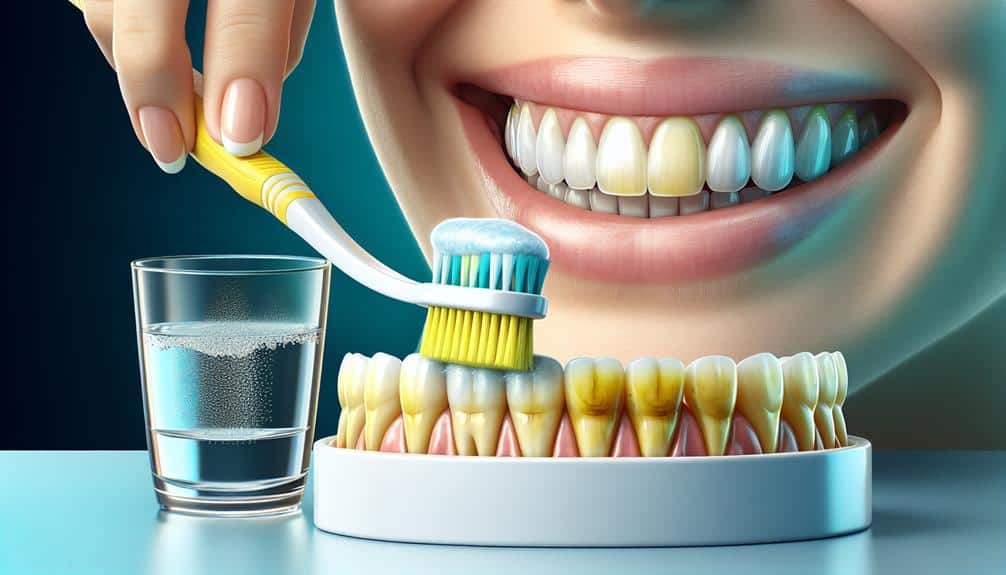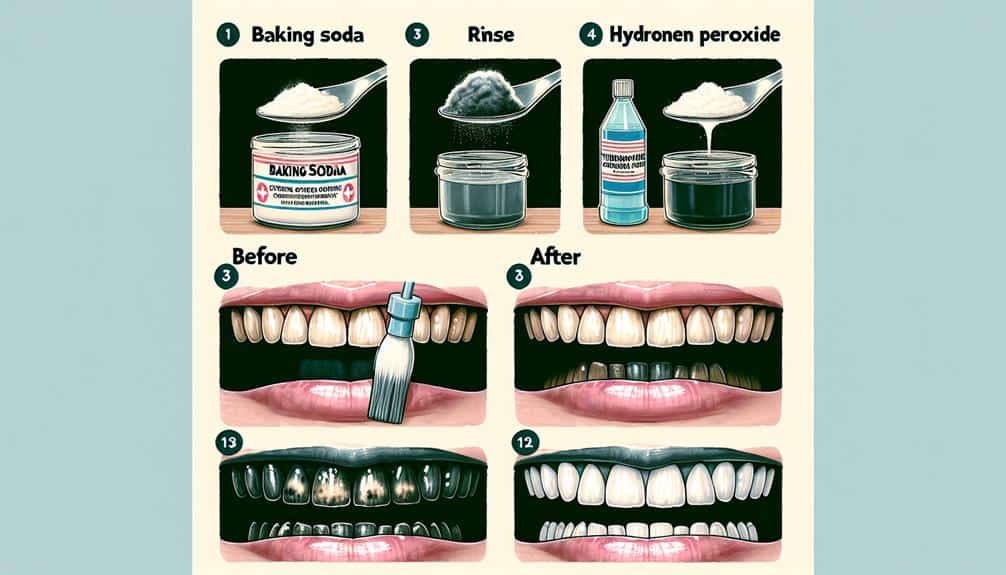Whiten your tetracycline-stained teeth with these DIY solutions: Lemon juice and baking soda scrub, hydrogen peroxide rinse, activated charcoal paste, coconut oil pulling, and turmeric whitening gel. Lemon has natural bleaching properties, while baking soda acts as a gentle scrub. Hydrogen peroxide is effective but should be diluted. Activated charcoal absorbs stains, coconut oil reduces bacteria, and turmeric brightens teeth. Remember, use these remedies moderately to prevent enamel damage. A brighter smile is within reach with these simple at-home solutions.
Key Points
- Lemon juice and baking soda: natural bleaching and scrub combo for surface stain removal.
- Hydrogen peroxide rinse: effective for tetracycline-stained teeth whitening without swallowing.
- Activated charcoal paste: adsorbs stains, particularly tetracycline, with careful use to prevent enamel damage.
- Oil pulling with coconut oil: reduces bacteria, fights plaque, and aids in whitening over time.
- DIY turmeric whitening gel: anti-inflammatory properties brighten teeth naturally with curcumin compound.
Lemon Juice and Baking Soda
For effective teeth whitening at home, you may consider using a mixture of lemon juice and baking soda. Lemon juice contains citrus acidity, which can act as a natural bleaching agent. When combined with baking soda, which acts as an abrasive scrub, this mixture can help remove surface stains on teeth, including those caused by tetracycline.
Citrus fruits like lemons are known for their natural acidity, which can help break down stains and brighten teeth. The abrasive nature of baking soda aids in the removal of plaque and stains, revealing a whiter smile. However, it's essential to use this mixture with caution, as the acidic nature of lemon juice can potentially erode tooth enamel over time if used excessively.
To create this DIY whitening solution, mix a small amount of lemon juice with baking soda to form a paste. Gently apply the paste to your teeth using a toothbrush or your finger, being careful not to scrub too vigorously. After a couple of minutes, thoroughly rinse your mouth to remove the mixture. It's recommended to use this method sparingly to prevent any damage to your enamel.
Hydrogen Peroxide Rinse
An effective method for whitening tetracycline-stained teeth is through the use of a hydrogen peroxide rinse. Hydrogen peroxide has been shown to be effective in removing stains and improving the overall appearance of teeth. To create a hydrogen peroxide rinse, simply mix equal parts of 3% hydrogen peroxide and water. Swish this solution around your mouth for about 30 seconds, being careful not to swallow it, and then spit it out. It's crucial to use this rinse in moderation to avoid any potential damage to the enamel.
When incorporating hydrogen peroxide rinses into your oral hygiene routine, it's important to remember that while it can help whiten teeth, it shouldn't replace your regular toothpaste. Additionally, make sure to follow good oral hygiene practices such as brushing twice a day, flossing, and visiting your dentist regularly. The benefits of using a hydrogen peroxide rinse include its ability to kill bacteria in the mouth, reduce bad breath, and help maintain overall oral health.
Activated Charcoal Paste
Activated charcoal paste is a popular natural remedy for whitening teeth that may help reduce the appearance of tetracycline stains. It's believed to work by adsorbing surface stains and toxins from the teeth and mouth. To make an activated charcoal paste, mix a small amount of activated charcoal powder with water to form a paste-like consistency. Gently brush the paste onto your teeth, allowing it to sit for a few minutes before rinsing thoroughly. It's important to use activated charcoal paste sparingly, as excessive use may wear down tooth enamel over time.
When using natural remedies like activated charcoal paste for teeth whitening, it's vital to remember that consistency is key. While these methods can help brighten your smile, they may not provide instant results, and regular use over time may be needed to see significant changes. Additionally, maintaining good oral hygiene practices such as regular brushing, flossing, and dental check-ups are crucial for overall oral health. Remember, always consult with your dentist before trying new oral health tips or remedies to make sure they're suitable for your specific dental needs.
Oil Pulling With Coconut Oil
To further enhance your teeth whitening efforts, contemplate integrating oil pulling with coconut oil into your oral care routine. Oil pulling is a traditional practice known for its potential benefits in oral hygiene and teeth whitening. Here are some key points to ponder:
- Health Benefits: Oil pulling with coconut oil can help reduce harmful bacteria in the mouth, potentially improving overall oral health.
- Oral Hygiene: Coconut oil contains lauric acid, which has antimicrobial properties that may help in combating plaque buildup and gingivitis.
- Whitening Effect: Some proponents suggest that oil pulling can help remove stains from the teeth's surface, contributing to a brighter smile over time.
Incorporating oil pulling into your daily routine can be a natural and holistic approach to complement your teeth whitening journey. Remember to continue other good oral hygiene practices such as regular brushing and flossing for the best results.
DIY Whitening Gel With Turmeric
Consider creating a DIY whitening gel using turmeric to naturally enhance the brightness of your teeth. Turmeric, known for its anti-inflammatory and antioxidant properties, can also benefit your oral health. To make a turmeric whitening gel, combine one tablespoon of turmeric powder with coconut oil to form a paste. Apply this mixture to your teeth and leave it on for about 5 minutes before rinsing thoroughly. The curcumin compound in turmeric has been shown to help reduce inflammation in the gums and promote overall oral health. Additionally, turmeric has natural teeth-whitening properties that can help diminish stains and brighten your smile over time.
DIY teeth whitening with turmeric offers a natural alternative to commercial whitening products, which may contain harsh chemicals. While turmeric can effectively whiten teeth, it's essential to use it in moderation to prevent staining. Incorporating this homemade turmeric whitening gel into your dental care routine can contribute to a healthier, brighter smile.
Frequently Asked Questions
Can Tetracycline-Stained Teeth Be Completely Whitened With These DIY Solutions?
To achieve complete whitening of tetracycline-stained teeth, consider professional treatments for the most effective results. Understand that long-term maintenance is essential for lasting brightness. Stay informed and seek expert advice for best outcomes.
Are There Any Potential Risks or Side Effects Associated With Using These DIY Whitening Methods?
When considering DIY whitening methods, be aware of potential risks and side effects. Effectiveness varies, and safety considerations are imperative. Research the ingredients thoroughly and consult with a dental professional to guarantee the safest approach for your teeth.
How Often Should These DIY Solutions Be Used to See Noticeable Results?
For noticeable results, use DIY solutions regularly. Consistency is key in achieving long-term effectiveness. The frequency of application plays an important role in the whitening process. By sticking to a routine, you can see significant improvements.
Are There Any Specific Toothpaste or Mouthwash Recommendations to Maintain Whitening Results?
To maintain whitening results, choose toothpaste with whitening properties like Colgate Optic White. Listerine Total Care is a recommended mouthwash. Brush gently in circular motions, floss daily, and schedule regular dental cleanings for best oral health.
Can These DIY Solutions Be Used in Conjunction With Professional Whitening Treatments for Better Results?
Combination treatments can enhance results when DIY solutions are used alongside professional whitening. Seek professional guidance to confirm compatibility and avoid negative interactions. This approach may lead to more effective and lasting whitening outcomes.



